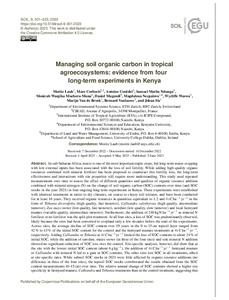| dc.contributor.author | Laub, M. |
| dc.contributor.author | Corbeels, M. |
| dc.contributor.author | Couedel, A. |
| dc.contributor.author | Ndungu, S.M. |
| dc.contributor.author | Mucheru-Muna, M. |
| dc.contributor.author | Mugendi, D. |
| dc.contributor.author | Necpalova, M. |
| dc.contributor.author | Waswa, W. |
| dc.contributor.author | Van de Broek, M. |
| dc.contributor.author | Vanlauwe, B. |
| dc.contributor.author | Six, J. |
| dc.date.accessioned | 2023-06-13T08:40:22Z |
| dc.date.available | 2023-06-13T08:40:22Z |
| dc.date.issued | 2023-06-05 |
| dc.identifier.citation | Laub, M., Corbeels, M., Couëdel, A., Ndungu, S.M., Mucheru-Muna, M., Mugendi, D., ... & Six, J. (2023). Managing soil organic carbon in tropical agroecosystems: evidence from four long-term experiments in Kenya. Soil, 9(1), 301-323. |
| dc.identifier.issn | 2199-3971 |
| dc.identifier.uri | https://hdl.handle.net/20.500.12478/8203 |
| dc.description.abstract | In sub-Saharan Africa, maize is one of the most important staple crops, but long-term maize cropping with low external inputs has been associated with the loss of soil fertility. While adding high-quality organic resources combined with mineral fertilizer has been proposed to counteract this fertility loss, the long-term effectiveness and interactions with site properties still require more understanding. This study used repeated measurements over time to assess the effect of different quantities and qualities of organic resource addition combined with mineral nitrogen (N) on the change of soil organic carbon (SOC) contents over time (and SOC stocks in the year 2021) in four ongoing long-term experiments in Kenya. These experiments were established with identical treatments in moist to dry climates, on coarse to clayey soil textures, and have been conducted for at least 16 years. They received organic resources in quantities equivalent to 1.2 and 4 t C ha−1 yr−1 in the form of Tithonia diversifolia (high quality, fast turnover), Calliandra calothyrsus (high quality, intermediate turnover), Zea mays stover (low quality, fast turnover), sawdust (low quality, slow turnover) and local farmyard manure (variable quality, intermediate turnover). Furthermore, the addition of 240 kg N ha−1 yr−1 as mineral N fertilizer or no fertilizer was the split-plot treatment. At all four sites, a loss of SOC was predominantly observed, likely because the sites had been converted to cropland only a few decades before the start of the experiments. Across sites, the average decline of SOC content over 19 years in the 0 to 15 cm topsoil layer ranged from 42 % to 13 % of the initial SOC content for the control and the farmyard manure treatments at 4 t C ha−1 yr−1, respectively. Adding Calliandra or Tithonia at 4 t C ha−1 yr−1 limited the loss of SOC contents to about 24 % of initial SOC, while the addition of sawdust, maize stover (in three of the four sites) and sole mineral N addition showed no significant reduction of SOC loss over the control. Site-specific analyses, however, did show that at the site with the lowest initial SOC content (about 6 g kg−1), the addition of 4 t C ha−1 yr−1 farmyard manure or Calliandra with mineral N led to a gain in SOC contents. The other sites lost SOC in all treatments, albeit at site-specific rates. While subsoil SOC stocks in 2021 were little affected by organic resource additions (no difference in three of the four sites), the topsoil SOC stocks corroborated the results obtained from the SOC content measurements (0–15 cm) over time. The relative annual change of SOC contents showed a higher site specificity in farmyard manure, Calliandra and Tithonia treatments than in the control treatment, suggesting that the drivers of site specificity in SOC buildup (soil mineralogy, soil texture, climate) need to be better understood for effective targeting management of organic resources. Farmyard manure showed the highest potential for reducing SOC losses, but the necessary quantities to build SOC are often not realistic for smallholder farmers in Africa. Therefore, additional agronomic interventions such as intercropping, crop rotations or the cultivation of crops with extended root systems are necessary to maintain or increase SOC. |
| dc.description.sponsorship | Schweizerischer Nationalfonds zur Förderung der Wissenschaftlichen Forschung |
| dc.description.sponsorship | The Agropolis Fondation |
| dc.description.sponsorship | The Total Foundation |
| dc.description.sponsorship | The European Union’s Horizon 2020 Framework |
| dc.format.extent | 301-323 |
| dc.language.iso | en |
| dc.subject | Soil Fertility |
| dc.subject | Organic Fertilizers |
| dc.subject | Food Security |
| dc.subject | Maize |
| dc.subject | Sub-Saharan Africa |
| dc.subject | Farmyard Manure |
| dc.title | Managing soil organic carbon in tropical agroecosystems: evidence from four long-term experiments in Kenya |
| dc.type | Journal Article |
| cg.contributor.crp | Maize |
| cg.contributor.crp | Roots, Tubers and Bananas |
| cg.contributor.affiliation | ETH Zurich |
| cg.contributor.affiliation | Centre de Coopération Internationale en Recherche Agronomique pour le Développement |
| cg.contributor.affiliation | International Institute of Tropical Agriculture |
| cg.contributor.affiliation | Kenyatta University |
| cg.contributor.affiliation | University of Embu |
| cg.contributor.affiliation | University College Dublin |
| cg.coverage.region | Africa |
| cg.coverage.region | East Africa |
| cg.coverage.country | Kenya |
| cg.coverage.hub | Central Africa Hub |
| cg.researchtheme | Natural Resource Management |
| cg.identifier.bibtexciteid | TIZE:2023d |
| cg.isijournal | ISI Journal |
| cg.authorship.types | CGIAR and developing country institute |
| cg.iitasubject | Agronomy |
| cg.iitasubject | Food Security |
| cg.iitasubject | Maize |
| cg.iitasubject | Plant Breeding |
| cg.iitasubject | Plant Production |
| cg.iitasubject | Soil Fertility |
| cg.journal | Soil |
| cg.notes | Open Access Journal; Published online: 05 Jun 2023 |
| cg.accessibilitystatus | Open Access |
| cg.reviewstatus | Peer Review |
| cg.usagerightslicense | Creative Commons Attribution 4.0 (CC BY 0.0) |
| cg.targetaudience | Scientists |
| cg.identifier.doi | https://doi.org/10.5194/soil-9-301-2023 |
| cg.iitaauthor.identifier | bernard vanlauwe: 0000-0001-6016-6027 |
| cg.futureupdate.required | No |
| cg.identifier.issue | 1 |
| cg.identifier.volume | 9 |

